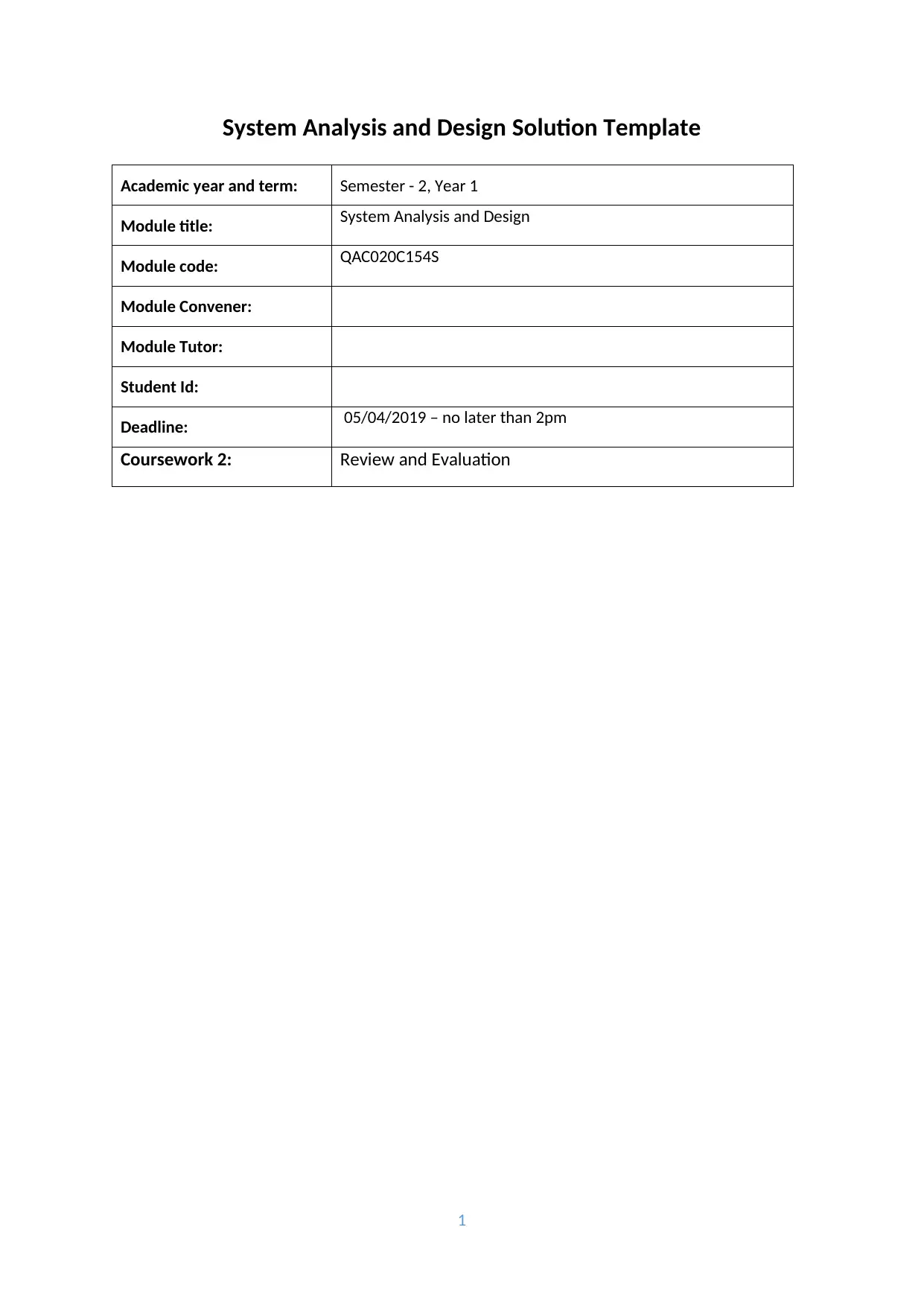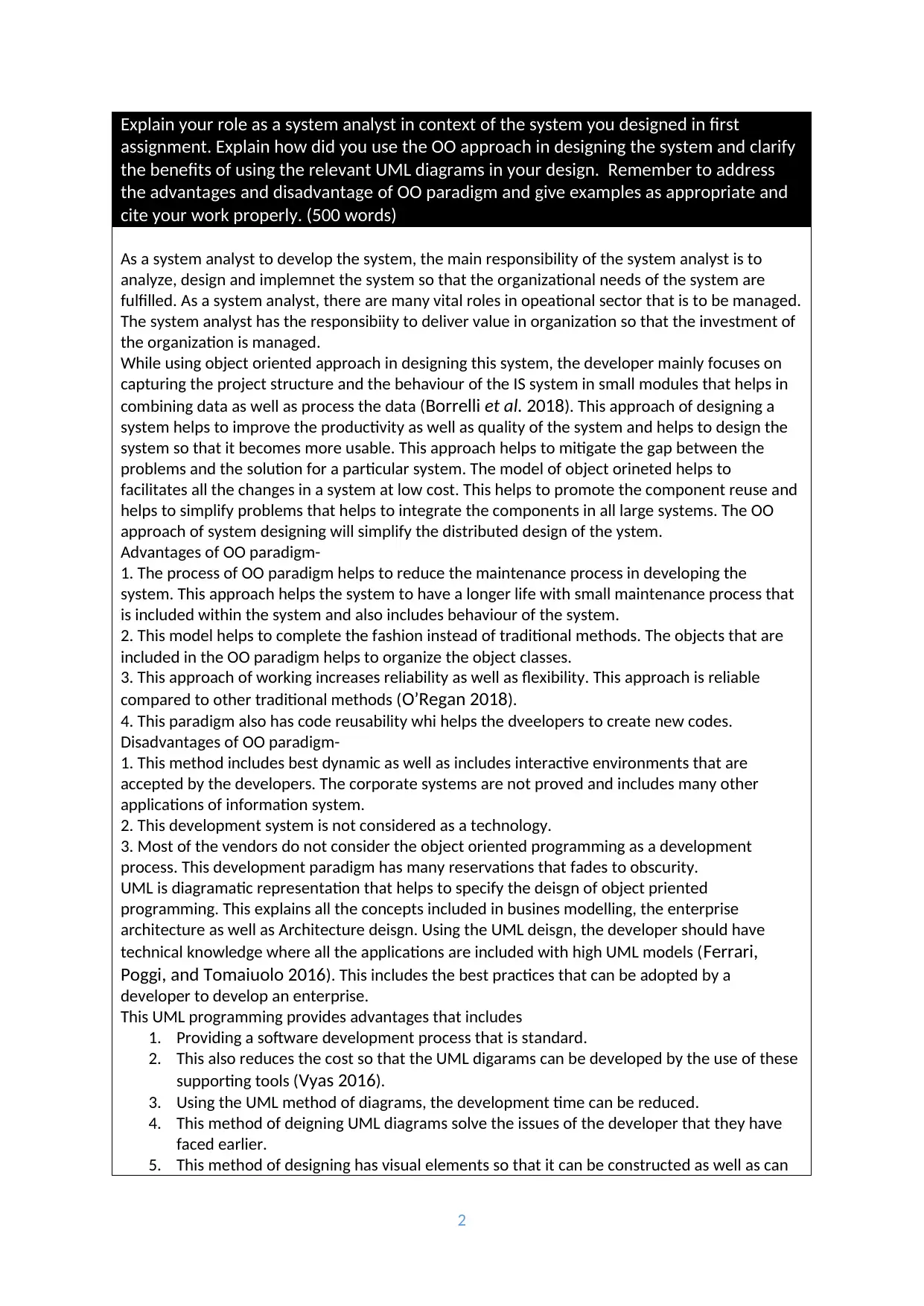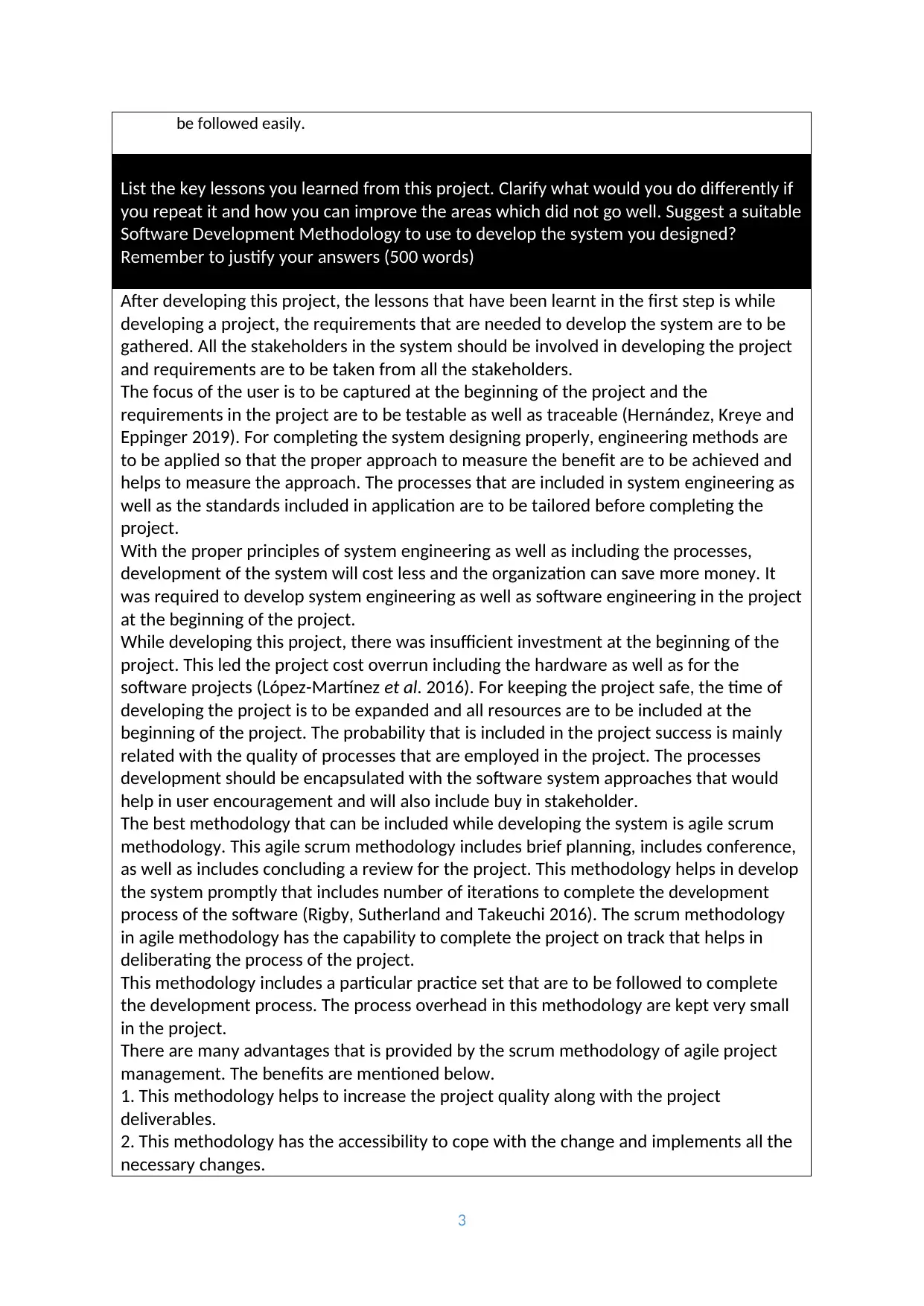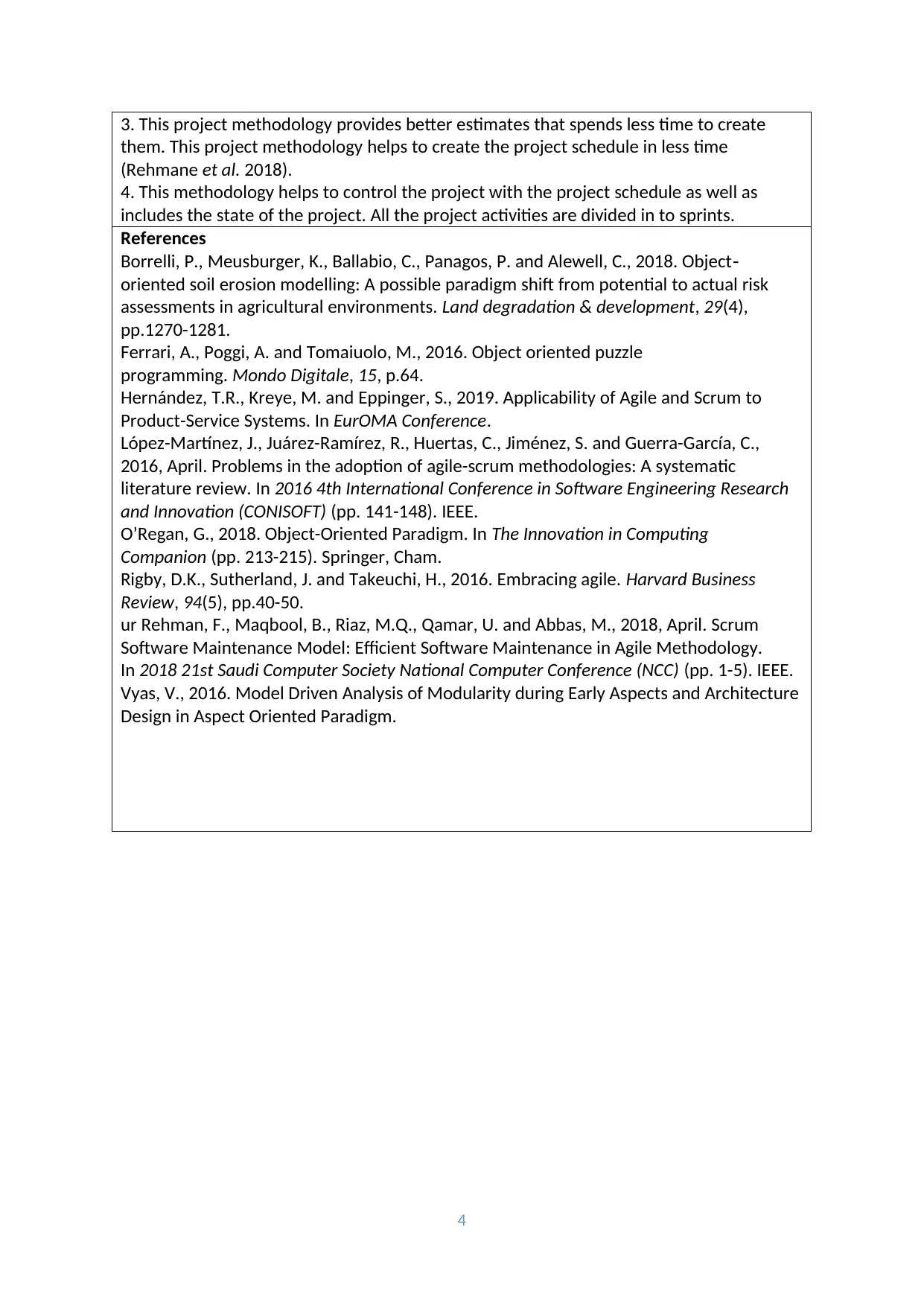University System Analysis and Design Review Report - QAC020C154S
VerifiedAdded on 2022/09/28
|4
|1665
|41
Report
AI Summary
This report analyzes a system analysis and design project, focusing on the role of a system analyst, the application of the Object-Oriented (OO) approach, and the use of UML diagrams. It explores the advantages and disadvantages of the OO paradigm, providing examples and proper citations. The report then discusses key lessons learned, suggests improvements for future projects, and recommends the Agile Scrum methodology for software development, justifying the choice with its benefits like increased project quality, adaptability to change, and efficient project scheduling. The analysis includes a review of the project's challenges and the importance of comprehensive planning and resource allocation, with references to supporting literature.

System Analysis and Design Solution Template
Academic year and term: Semester - 2, Year 1
Module title: System Analysis and Design
Module code: QAC020C154S
Module Convener:
Module Tutor:
Student Id:
Deadline: 05/04/2019 – no later than 2pm
Coursework 2: Review and Evaluation
1
Academic year and term: Semester - 2, Year 1
Module title: System Analysis and Design
Module code: QAC020C154S
Module Convener:
Module Tutor:
Student Id:
Deadline: 05/04/2019 – no later than 2pm
Coursework 2: Review and Evaluation
1
Paraphrase This Document
Need a fresh take? Get an instant paraphrase of this document with our AI Paraphraser

Explain your role as a system analyst in context of the system you designed in first
assignment. Explain how did you use the OO approach in designing the system and clarify
the benefits of using the relevant UML diagrams in your design. Remember to address
the advantages and disadvantage of OO paradigm and give examples as appropriate and
cite your work properly. (500 words)
As a system analyst to develop the system, the main responsibility of the system analyst is to
analyze, design and implemnet the system so that the organizational needs of the system are
fulfilled. As a system analyst, there are many vital roles in opeational sector that is to be managed.
The system analyst has the responsibiity to deliver value in organization so that the investment of
the organization is managed.
While using object oriented approach in designing this system, the developer mainly focuses on
capturing the project structure and the behaviour of the IS system in small modules that helps in
combining data as well as process the data (Borrelli et al. 2018). This approach of designing a
system helps to improve the productivity as well as quality of the system and helps to design the
system so that it becomes more usable. This approach helps to mitigate the gap between the
problems and the solution for a particular system. The model of object orineted helps to
facilitates all the changes in a system at low cost. This helps to promote the component reuse and
helps to simplify problems that helps to integrate the components in all large systems. The OO
approach of system designing will simplify the distributed design of the ystem.
Advantages of OO paradigm-
1. The process of OO paradigm helps to reduce the maintenance process in developing the
system. This approach helps the system to have a longer life with small maintenance process that
is included within the system and also includes behaviour of the system.
2. This model helps to complete the fashion instead of traditional methods. The objects that are
included in the OO paradigm helps to organize the object classes.
3. This approach of working increases reliability as well as flexibility. This approach is reliable
compared to other traditional methods (O’Regan 2018).
4. This paradigm also has code reusability whi helps the dveelopers to create new codes.
Disadvantages of OO paradigm-
1. This method includes best dynamic as well as includes interactive environments that are
accepted by the developers. The corporate systems are not proved and includes many other
applications of information system.
2. This development system is not considered as a technology.
3. Most of the vendors do not consider the object oriented programming as a development
process. This development paradigm has many reservations that fades to obscurity.
UML is diagramatic representation that helps to specify the deisgn of object priented
programming. This explains all the concepts included in busines modelling, the enterprise
architecture as well as Architecture deisgn. Using the UML deisgn, the developer should have
technical knowledge where all the applications are included with high UML models (Ferrari,
Poggi, and Tomaiuolo 2016). This includes the best practices that can be adopted by a
developer to develop an enterprise.
This UML programming provides advantages that includes
1. Providing a software development process that is standard.
2. This also reduces the cost so that the UML digarams can be developed by the use of these
supporting tools (Vyas 2016).
3. Using the UML method of diagrams, the development time can be reduced.
4. This method of deigning UML diagrams solve the issues of the developer that they have
faced earlier.
5. This method of designing has visual elements so that it can be constructed as well as can
2
assignment. Explain how did you use the OO approach in designing the system and clarify
the benefits of using the relevant UML diagrams in your design. Remember to address
the advantages and disadvantage of OO paradigm and give examples as appropriate and
cite your work properly. (500 words)
As a system analyst to develop the system, the main responsibility of the system analyst is to
analyze, design and implemnet the system so that the organizational needs of the system are
fulfilled. As a system analyst, there are many vital roles in opeational sector that is to be managed.
The system analyst has the responsibiity to deliver value in organization so that the investment of
the organization is managed.
While using object oriented approach in designing this system, the developer mainly focuses on
capturing the project structure and the behaviour of the IS system in small modules that helps in
combining data as well as process the data (Borrelli et al. 2018). This approach of designing a
system helps to improve the productivity as well as quality of the system and helps to design the
system so that it becomes more usable. This approach helps to mitigate the gap between the
problems and the solution for a particular system. The model of object orineted helps to
facilitates all the changes in a system at low cost. This helps to promote the component reuse and
helps to simplify problems that helps to integrate the components in all large systems. The OO
approach of system designing will simplify the distributed design of the ystem.
Advantages of OO paradigm-
1. The process of OO paradigm helps to reduce the maintenance process in developing the
system. This approach helps the system to have a longer life with small maintenance process that
is included within the system and also includes behaviour of the system.
2. This model helps to complete the fashion instead of traditional methods. The objects that are
included in the OO paradigm helps to organize the object classes.
3. This approach of working increases reliability as well as flexibility. This approach is reliable
compared to other traditional methods (O’Regan 2018).
4. This paradigm also has code reusability whi helps the dveelopers to create new codes.
Disadvantages of OO paradigm-
1. This method includes best dynamic as well as includes interactive environments that are
accepted by the developers. The corporate systems are not proved and includes many other
applications of information system.
2. This development system is not considered as a technology.
3. Most of the vendors do not consider the object oriented programming as a development
process. This development paradigm has many reservations that fades to obscurity.
UML is diagramatic representation that helps to specify the deisgn of object priented
programming. This explains all the concepts included in busines modelling, the enterprise
architecture as well as Architecture deisgn. Using the UML deisgn, the developer should have
technical knowledge where all the applications are included with high UML models (Ferrari,
Poggi, and Tomaiuolo 2016). This includes the best practices that can be adopted by a
developer to develop an enterprise.
This UML programming provides advantages that includes
1. Providing a software development process that is standard.
2. This also reduces the cost so that the UML digarams can be developed by the use of these
supporting tools (Vyas 2016).
3. Using the UML method of diagrams, the development time can be reduced.
4. This method of deigning UML diagrams solve the issues of the developer that they have
faced earlier.
5. This method of designing has visual elements so that it can be constructed as well as can
2

be followed easily.
List the key lessons you learned from this project. Clarify what would you do differently if
you repeat it and how you can improve the areas which did not go well. Suggest a suitable
Software Development Methodology to use to develop the system you designed?
Remember to justify your answers (500 words)
After developing this project, the lessons that have been learnt in the first step is while
developing a project, the requirements that are needed to develop the system are to be
gathered. All the stakeholders in the system should be involved in developing the project
and requirements are to be taken from all the stakeholders.
The focus of the user is to be captured at the beginning of the project and the
requirements in the project are to be testable as well as traceable (Hernández, Kreye and
Eppinger 2019). For completing the system designing properly, engineering methods are
to be applied so that the proper approach to measure the benefit are to be achieved and
helps to measure the approach. The processes that are included in system engineering as
well as the standards included in application are to be tailored before completing the
project.
With the proper principles of system engineering as well as including the processes,
development of the system will cost less and the organization can save more money. It
was required to develop system engineering as well as software engineering in the project
at the beginning of the project.
While developing this project, there was insufficient investment at the beginning of the
project. This led the project cost overrun including the hardware as well as for the
software projects (López-Martínez et al. 2016). For keeping the project safe, the time of
developing the project is to be expanded and all resources are to be included at the
beginning of the project. The probability that is included in the project success is mainly
related with the quality of processes that are employed in the project. The processes
development should be encapsulated with the software system approaches that would
help in user encouragement and will also include buy in stakeholder.
The best methodology that can be included while developing the system is agile scrum
methodology. This agile scrum methodology includes brief planning, includes conference,
as well as includes concluding a review for the project. This methodology helps in develop
the system promptly that includes number of iterations to complete the development
process of the software (Rigby, Sutherland and Takeuchi 2016). The scrum methodology
in agile methodology has the capability to complete the project on track that helps in
deliberating the process of the project.
This methodology includes a particular practice set that are to be followed to complete
the development process. The process overhead in this methodology are kept very small
in the project.
There are many advantages that is provided by the scrum methodology of agile project
management. The benefits are mentioned below.
1. This methodology helps to increase the project quality along with the project
deliverables.
2. This methodology has the accessibility to cope with the change and implements all the
necessary changes.
3
List the key lessons you learned from this project. Clarify what would you do differently if
you repeat it and how you can improve the areas which did not go well. Suggest a suitable
Software Development Methodology to use to develop the system you designed?
Remember to justify your answers (500 words)
After developing this project, the lessons that have been learnt in the first step is while
developing a project, the requirements that are needed to develop the system are to be
gathered. All the stakeholders in the system should be involved in developing the project
and requirements are to be taken from all the stakeholders.
The focus of the user is to be captured at the beginning of the project and the
requirements in the project are to be testable as well as traceable (Hernández, Kreye and
Eppinger 2019). For completing the system designing properly, engineering methods are
to be applied so that the proper approach to measure the benefit are to be achieved and
helps to measure the approach. The processes that are included in system engineering as
well as the standards included in application are to be tailored before completing the
project.
With the proper principles of system engineering as well as including the processes,
development of the system will cost less and the organization can save more money. It
was required to develop system engineering as well as software engineering in the project
at the beginning of the project.
While developing this project, there was insufficient investment at the beginning of the
project. This led the project cost overrun including the hardware as well as for the
software projects (López-Martínez et al. 2016). For keeping the project safe, the time of
developing the project is to be expanded and all resources are to be included at the
beginning of the project. The probability that is included in the project success is mainly
related with the quality of processes that are employed in the project. The processes
development should be encapsulated with the software system approaches that would
help in user encouragement and will also include buy in stakeholder.
The best methodology that can be included while developing the system is agile scrum
methodology. This agile scrum methodology includes brief planning, includes conference,
as well as includes concluding a review for the project. This methodology helps in develop
the system promptly that includes number of iterations to complete the development
process of the software (Rigby, Sutherland and Takeuchi 2016). The scrum methodology
in agile methodology has the capability to complete the project on track that helps in
deliberating the process of the project.
This methodology includes a particular practice set that are to be followed to complete
the development process. The process overhead in this methodology are kept very small
in the project.
There are many advantages that is provided by the scrum methodology of agile project
management. The benefits are mentioned below.
1. This methodology helps to increase the project quality along with the project
deliverables.
2. This methodology has the accessibility to cope with the change and implements all the
necessary changes.
3
⊘ This is a preview!⊘
Do you want full access?
Subscribe today to unlock all pages.

Trusted by 1+ million students worldwide

3. This project methodology provides better estimates that spends less time to create
them. This project methodology helps to create the project schedule in less time
(Rehmane et al. 2018).
4. This methodology helps to control the project with the project schedule as well as
includes the state of the project. All the project activities are divided in to sprints.
References
Borrelli, P., Meusburger, K., Ballabio, C., Panagos, P. and Alewell, C., 2018. Object‐
oriented soil erosion modelling: A possible paradigm shift from potential to actual risk
assessments in agricultural environments. Land degradation & development, 29(4),
pp.1270-1281.
Ferrari, A., Poggi, A. and Tomaiuolo, M., 2016. Object oriented puzzle
programming. Mondo Digitale, 15, p.64.
Hernández, T.R., Kreye, M. and Eppinger, S., 2019. Applicability of Agile and Scrum to
Product-Service Systems. In EurOMA Conference.
López-Martínez, J., Juárez-Ramírez, R., Huertas, C., Jiménez, S. and Guerra-García, C.,
2016, April. Problems in the adoption of agile-scrum methodologies: A systematic
literature review. In 2016 4th International Conference in Software Engineering Research
and Innovation (CONISOFT) (pp. 141-148). IEEE.
O’Regan, G., 2018. Object-Oriented Paradigm. In The Innovation in Computing
Companion (pp. 213-215). Springer, Cham.
Rigby, D.K., Sutherland, J. and Takeuchi, H., 2016. Embracing agile. Harvard Business
Review, 94(5), pp.40-50.
ur Rehman, F., Maqbool, B., Riaz, M.Q., Qamar, U. and Abbas, M., 2018, April. Scrum
Software Maintenance Model: Efficient Software Maintenance in Agile Methodology.
In 2018 21st Saudi Computer Society National Computer Conference (NCC) (pp. 1-5). IEEE.
Vyas, V., 2016. Model Driven Analysis of Modularity during Early Aspects and Architecture
Design in Aspect Oriented Paradigm.
4
them. This project methodology helps to create the project schedule in less time
(Rehmane et al. 2018).
4. This methodology helps to control the project with the project schedule as well as
includes the state of the project. All the project activities are divided in to sprints.
References
Borrelli, P., Meusburger, K., Ballabio, C., Panagos, P. and Alewell, C., 2018. Object‐
oriented soil erosion modelling: A possible paradigm shift from potential to actual risk
assessments in agricultural environments. Land degradation & development, 29(4),
pp.1270-1281.
Ferrari, A., Poggi, A. and Tomaiuolo, M., 2016. Object oriented puzzle
programming. Mondo Digitale, 15, p.64.
Hernández, T.R., Kreye, M. and Eppinger, S., 2019. Applicability of Agile and Scrum to
Product-Service Systems. In EurOMA Conference.
López-Martínez, J., Juárez-Ramírez, R., Huertas, C., Jiménez, S. and Guerra-García, C.,
2016, April. Problems in the adoption of agile-scrum methodologies: A systematic
literature review. In 2016 4th International Conference in Software Engineering Research
and Innovation (CONISOFT) (pp. 141-148). IEEE.
O’Regan, G., 2018. Object-Oriented Paradigm. In The Innovation in Computing
Companion (pp. 213-215). Springer, Cham.
Rigby, D.K., Sutherland, J. and Takeuchi, H., 2016. Embracing agile. Harvard Business
Review, 94(5), pp.40-50.
ur Rehman, F., Maqbool, B., Riaz, M.Q., Qamar, U. and Abbas, M., 2018, April. Scrum
Software Maintenance Model: Efficient Software Maintenance in Agile Methodology.
In 2018 21st Saudi Computer Society National Computer Conference (NCC) (pp. 1-5). IEEE.
Vyas, V., 2016. Model Driven Analysis of Modularity during Early Aspects and Architecture
Design in Aspect Oriented Paradigm.
4
1 out of 4
Related Documents
Your All-in-One AI-Powered Toolkit for Academic Success.
+13062052269
info@desklib.com
Available 24*7 on WhatsApp / Email
![[object Object]](/_next/static/media/star-bottom.7253800d.svg)
Unlock your academic potential
Copyright © 2020–2025 A2Z Services. All Rights Reserved. Developed and managed by ZUCOL.





